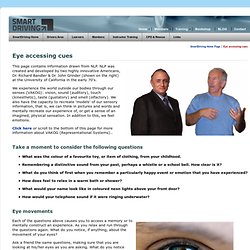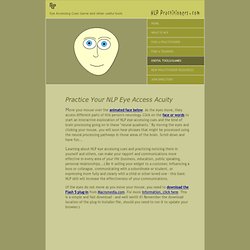

Integral Eye Movement Therapy. Eye_cues_chart.gif (GIF Image, 1122x1062 pixels) - Scaled (80%) Eye Patterns (NLP) NLP eye accessing cues. This page contains information drawn from NLP.

NLP was created and developed by two highly innovative Americans, Dr. Richard Bandler & Dr. John Grinder (shown on the right) at the University of California in the early 70's. We experience the world outside our bodies through our senses (VAKOG): vision, sound (auditory), touch (kinesthetic), taste (gustatory) and smell (olfactory). We also have the capacity to recreate 'models' of our sensory information, that is, we can think in pictures and words and mentally recreate our experience of, or get a sense of an imagined, physical sensation. Click here or scroll to the bottom of this page for more information about VAKOG (Representational Systems).. Take a moment to consider the following questions What was the colour of a favourite toy, or item of clothing, from your childhood.
Eye movements Each of the questions above causes you to access a memory or to mentally construct an experience. Eye Movement and Lying - How to detect lies. Interesting Info -> Lying Index -> Eye Direction & Visual Accessing Cues Eye Movement and Direction & How it Can Reveal Truth or Lies This is a continuation of our previous article Detecting Lies.

Many comments by our visitors asked about how eye direction can indicate the presence of a lie. Can the direction a person's eyes reveal whether or not they are making a truthful statement? Short answer: sort of. In these shows a detective will deduce if a person is being untruthful simply because they looked to the left or right while making a statement. In reality, it would be foolish to make such a snap judgment without further investigation... but the technique does have some merit. So, here it is... read, ponder and test it on your friends and family to see how reliable it is for yourself.
Visual Accessing Cues - "Lying Eyes" When asked a question a "normally organized" right-handed person looks (from your viewpoint, looking at them): The Gist of it... Eye Accessing Test. NLP eye access cues game - learn Neuro Linguistic Programming eye accessing. Move your mouse over the animated face below.

As the eyes move, they access different parts of this person's neurology. Click on the face or words to start an interactive exploration of NLP eye-accessing cues and the kind of brain processing going on in these "neural quadrants. " By moving the eyes and clicking your mouse, you will soon hear phrases that might be processed using the neural processing pathways in those areas of the brain. Scroll down and have fun... Learning about NLP eye accessing cues and practicing noticing them in yourself and others, can make your rapport and communications more effective in every area of your life (business, education, public speaking, personal relationships...)
(If the eyes do not move as you move your mouse, you need to download the Flash 5 plug-in from Macromedia.com. V K A O G - Visual Audio Kinesthetic Olfactory Gustatory Systems When we look up, we generally are connecting with pictures. Preferred VKAOG Neural Processing Sequence. NLP. We think primarily in one of three representational systems; pictures, sounds or feelings. By paying close attention to a persons unconscious eye movements you are able to determine which representational system they are using to access information... and by consciously moving your eyes to a specific location you are able to access different representational systems that will aid with remembering or constructing thoughts!
Once you are aware of which system your client is using you can speak to them in their language. For example, if they keep looking up during the conversation they are accessing visual information and a greater sense of rapport (what is rapport? Click here ) would be gained by using visual terminology, such as, ‘That looks great!’ ‘What a bright idea.’ If a person looks up they are accessing visual information. Similarly, if we look to the side it can help us to remember or imagine sounds. Eye movements can also be used consciously.